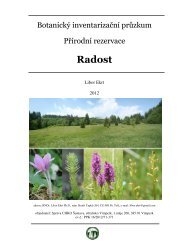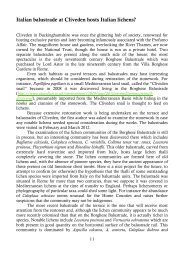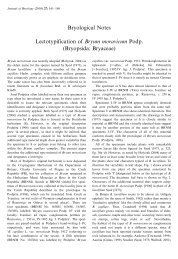Bryophyte flora of the Czech Republic: updated checklist and Red ...
Bryophyte flora of the Czech Republic: updated checklist and Red ...
Bryophyte flora of the Czech Republic: updated checklist and Red ...
You also want an ePaper? Increase the reach of your titles
YUMPU automatically turns print PDFs into web optimized ePapers that Google loves.
842 Preslia 84: 813–850, 2012<br />
Campylopus pyriformis – was first reported from <strong>the</strong> <strong>Czech</strong> <strong>Republic</strong> in <strong>the</strong> 2003 <strong>checklist</strong>, although <strong>the</strong> revision<br />
<strong>of</strong> herbarium material showed that it was collected earlier (one from 1899 <strong>and</strong> ano<strong>the</strong>r from 1968). It is currently<br />
widely scattered in south-western <strong>and</strong> <strong>the</strong> sou<strong>the</strong>rn part <strong>of</strong> <strong>the</strong> country <strong>and</strong> is perhaps still spreading.<br />
Bryoerythrophyllum ferruginascens – first reported from this country by Pilous (1993), based on <strong>the</strong><br />
adventive occurrence in an ab<strong>and</strong>oned limestone pit. Since <strong>the</strong>n, <strong>the</strong> species seems to be spreading in similar habitats<br />
<strong>and</strong> along <strong>the</strong> roads <strong>and</strong> interestingly, <strong>the</strong> revision <strong>of</strong> unidentified herbarium material <strong>of</strong> Pottiaceae, revealed<br />
earlier collections, among o<strong>the</strong>rs <strong>the</strong> probably native occurrence on rocks in <strong>the</strong> Hrubý Jeseník Mts.<br />
Dicranum tauricum – according to <strong>the</strong> bryo<strong>flora</strong> <strong>of</strong> <strong>Czech</strong>oslovakia (Pilous & Duda 1960), this species was<br />
reported to occur only ‘rarely in eastern Slovakia’. First <strong>Czech</strong> reports started to appear in early 1990s (Anonymous<br />
1993). Franklová (1997) summarized <strong>the</strong> known distribution, based on an old herbarium record from 1927,<br />
two records from 1977–1978 <strong>and</strong> an increasing number <strong>of</strong> records since 1989.<br />
Dicranoweisia cirrata – known from <strong>the</strong> <strong>Czech</strong> <strong>Republic</strong> since <strong>the</strong> time <strong>of</strong> <strong>the</strong> early bryological studies but<br />
recorded only extremely sporadically between <strong>the</strong> first record in 1884 <strong>and</strong> early 1980s (Plášek 2001). Since <strong>the</strong>n,<br />
<strong>the</strong> species has spread widely, particularly as an epiphyte.<br />
Orthotrichum pulchellum – apparently native in western Europe <strong>and</strong> o<strong>the</strong>rwise occurring only in western<br />
North America but now a cryptogenic species spreading in many countries <strong>of</strong> western to central Europe. Its rapid<br />
expansion after apparently completely vanishing in Germany started in early 1990s (Frahm 2002), toge<strong>the</strong>r with<br />
o<strong>the</strong>r (sub)oceanic taxa (Ulota phyllantha, Zygodon conoideus, Dendrocryphaea lamyana, Orthotrichum consimile,<br />
Metzgeria temperata), <strong>of</strong> which <strong>the</strong> latter three have already been recorded in neighbouring Saxony <strong>and</strong> Bavaria<br />
(Müller 2004, Meinunger & Schröder 2007). The rate <strong>of</strong> spread <strong>of</strong> O. pulchellum is moderate <strong>and</strong> no adverse<br />
effect on native epiphytes has been observed.<br />
Orthotrichum rogeri – regarded as native, historically known from a single locality in nor<strong>the</strong>rn Moravia near<br />
Šumperk. Spreading at a moderate rate from Saxony since 2008 (Kučera 2009b) in a way comparable to that <strong>of</strong><br />
Orthotrichum pulchellum. The source <strong>of</strong> recolonization lies obviously outside <strong>the</strong> <strong>Czech</strong> <strong>Republic</strong>.<br />
Uncertain cases<br />
Zygodon dentatus, Orthotrichum patens, Metzgeria violacea, Orthotrichum tenellum <strong>and</strong> Microlejeunea ulicina<br />
<strong>and</strong> many o<strong>the</strong>r epiphytes might belong among taxa that have started to spread in this country, although in <strong>the</strong> case<br />
<strong>of</strong> <strong>the</strong> latter two species <strong>the</strong>re is only a single recent record, <strong>and</strong> <strong>the</strong>ir eventual spread is only inferred from <strong>the</strong> situation<br />
in neighbouring regions <strong>of</strong> Germany (Seifert 2009). The spread <strong>of</strong> epiphytes following <strong>the</strong> improvement in<br />
air quality in recent decades occurred in all central-European countries. It is interesting that <strong>the</strong> restored habitat is<br />
not simply being reclaimed by earlier occurring epiphytes but ra<strong>the</strong>r earlier unknown or extremely rarely occurring<br />
species emerge, <strong>of</strong>ten using migratory routes different from <strong>the</strong> historical ones (<strong>the</strong> above mentioned<br />
Orthotrichum rogeri, Zygodon viridissimus). The cases <strong>of</strong> recently spreading terrestrial bryophytes are less<br />
clearly documented but Endogemma caespiticia is an example; whe<strong>the</strong>r <strong>the</strong> terrestrial species <strong>of</strong> Bryum <strong>and</strong><br />
Pohlia with rhizoidal <strong>and</strong> axillary gemmae are spreading, is not known, as <strong>the</strong>y were recognized only in <strong>the</strong> last<br />
three decades.<br />
Phytogeographic considerations<br />
Phytogeographic aspects <strong>of</strong> <strong>the</strong> bryophytes occurring in <strong>the</strong> <strong>Czech</strong> <strong>Republic</strong> have never<br />
been studied in a comprehensive way <strong>and</strong> this task goes far beyond <strong>the</strong> scope <strong>of</strong> this article.<br />
The main problem is <strong>the</strong> incomplete knowledge <strong>of</strong> <strong>the</strong> world-wide distribution <strong>of</strong> those<br />
bryophytes occurring in Europe, <strong>and</strong> also <strong>the</strong> generally broad distribution pattern <strong>of</strong> most<br />
European bryophytes, which is very difficult to simplify <strong>and</strong> abstract in a way that could<br />
be easily used in regional bryophytogeographic analyses. Dierßen (2001) tried to summarize<br />
<strong>the</strong> available phytogeographic information on European bryophytes, based largely on<br />
earlier works by Düll, but his evaluation is difficult to apply for <strong>the</strong> above mentioned reasons<br />
<strong>and</strong> in many cases his evaluation is very different from our experience, hence we have<br />
refrained from presenting a general phytogeographic analysis <strong>of</strong> <strong>the</strong> <strong>Czech</strong> bryo<strong>flora</strong> <strong>and</strong><br />
a comparison with that <strong>of</strong> neighbouring countries.<br />
The geographic position <strong>of</strong> <strong>the</strong> <strong>Czech</strong> <strong>Republic</strong> in central Europe, which is influenced<br />
both by oceanic <strong>and</strong> continental climatic conditions but at <strong>the</strong> same time is protected from










